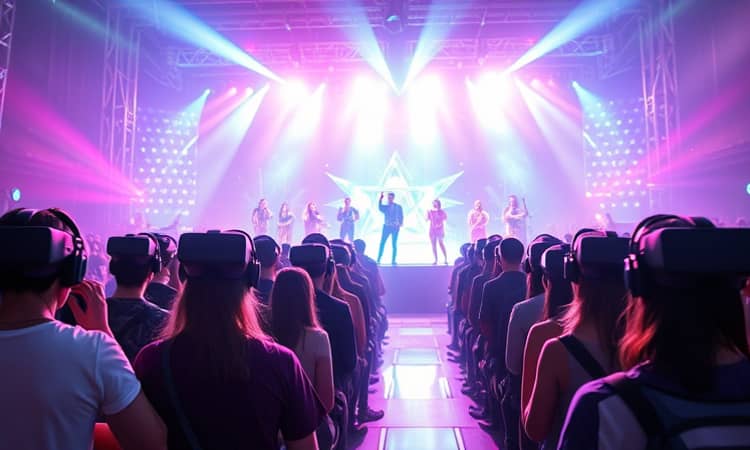Virtual concerts have become more than a pandemic-era necessity—they represent a profound shift in how we experience live music. As technology advances, audiences around the world are discovering new ways to connect with artists, share moments of joy, and feel part of a collective experience without ever leaving home.
Trends and Growth of Virtual Concerts
The virtual concert platform market is enjoying unprecedented global expansion, with projections estimating growth from $76.6 billion in 2023 to $115.6 billion by 2031. Other forecasts are even more optimistic, predicting a climb to $297 billion by 2030 at a 20% CAGR. This surge underscores how livestreamed events and immersive performances have become a permanent fixture in the music industry.
The COVID-19 pandemic accelerated adoption, proving that digital stages can offer lasting creative possibilities beyond emergency measures. By 2025, 81% of event managers intend to host virtual events, signaling that online formats are here to stay.
Audience Engagement and Accessibility
One of the greatest strengths of virtual concerts is their ability to remove traditional barriers. Geographic distance, physical disabilities, and high ticket costs no longer stand between fans and their favorite artists. Whether viewers log in from a rural town or a bustling metropolis, the experience is designed to be equally powerful.
Immersive technologies like AR and VR enhance engagement by allowing fans to explore interactive environments, trigger special effects, and even influence visual elements in real time. Hybrid events—where attendees choose between physical seats and digital avatars—are fast becoming the norm, blending the best of both worlds.
Massive viewership numbers illustrate this trend. In major virtual performances:
| Artist | Platform | Viewers |
|---|---|---|
| Ariana Grande | Fortnite | 78 million |
| Travis Scott | Fortnite | 11.7 million |
| Lil Nas X | Roblox | 33 million |
Monetization and Revenue
Virtual concerts have unlocked powerful new income streams for artists. Travis Scott’s ten-minute “Astronomical” event in Fortnite generated $20 million in revenue, eclipsing his best in-person tour night by over tenfold. Merchandising, exclusive digital goods, VIP virtual lounges, and branded sponsorships now contribute substantially to an artist’s bottom line.
The global live music market is expected to grow by $17.99 billion between 2025 and 2029, driven largely by virtual and hybrid formats. As more musicians and promoters embrace digital shows, we can anticipate further innovations in ticket tiers, augmented reality collectibles, and subscription-based fan clubs.
Technology and Innovation
Behind every successful virtual concert lies a suite of cutting-edge tools. Key advancements include:
- High-fidelity livestreaming with ultra-low latency
- Augmented reality overlays that blend real and digital worlds
- Virtual reality environments offering 360° immersion
- Interactive fan features like real-time polling and custom camera angles
Artists such as Coldplay have embraced mixed-reality adventures, layering real-time AR visuals on stage. Interactive tools empower fans to create shareable content, boosting social engagement and strengthening artist-fan bonds.
Market and Demographic Insights
Contrary to early misconceptions, virtual concerts appeal to more than just tech-savvy youth. US adults show greater interest in virtual performances than in digital shopping or live streaming of sports. The metaverse’s third most appealing feature is virtual events, ahead of socializing and gaming.
Independent artists benefit immensely. Without traditional gatekeepers, they can access global audiences, conduct creative experiments, and gather real-time feedback. Established stars leverage these platforms to expand their reach, creating a dynamic ecosystem where talent and technology converge.
Challenges and Limitations
Despite their promise, virtual concerts face hurdles. Privacy and security concerns around online ticketing and data handling remain top of mind. Additionally, replicating the emotional charge and social spontaneity of in-person shows is an ongoing challenge, though AR and VR advances continue to narrow the gap.
The digital divide also persists: not everyone has access to high-speed internet or advanced hardware. Finally, market saturation poses risks—without compelling differentiation, audiences may suffer from “virtual fatigue.” Curators and artists must therefore prioritize quality, novelty, and genuine interaction.
Sustainability and Other Benefits
Virtual and hybrid concerts offer significant environmental advantages. By reducing travel for performers and fans, carbon emissions can drop dramatically. Coldplay’s hybrid “Music of the Spheres” tour, for example, achieved a 47% CO₂ reduction compared to its previous stadium trek.
Beyond green credentials, organizers gain access to rich data on viewer behavior, enabling highly personalized marketing and fan experiences. Exclusive digital collectibles, targeted promos, and adaptive setlists can all be tailored based on insights drawn from live interactions.
Marketing and Promotion
Effective promotion is crucial to stand out in a crowded digital landscape. Winning strategies include:
- Partnering with influencers to reach niche communities
- Releasing exclusive behind-the-scenes teasers to build anticipation
- Harnessing social media challenges and hashtags for viral momentum
- Optimizing dedicated event landing pages for seamless ticket sales
By blending organic engagement with targeted ads, promoters can ensure that virtual events capture attention and convert curiosity into ticket purchases.
The Future Outlook
Industry analysts agree: virtual and hybrid concerts are more than a pandemic-era novelty—they are foundational elements of the entertainment ecosystem. Continued innovation in immersive tech, combined with audience demand for flexibility, will sustain growth.
As immersive experiences become more seamless and accessible, virtual concerts will evolve from supplementary offerings into premier events in their own right. Whether through holographic headliners, AI-generated visuals, or multi-sensory feedback, the stage of tomorrow promises to be boundless, inclusive, and ever more exhilarating.
In a world where connection transcends physical walls, virtual concerts stand as a testament to human creativity, resilience, and the enduring power of music to unite us all.
References
- https://imusician.pro/en/resources/blog/live-music-industry-in-2025
- https://www.prnewswire.com/news-releases/live-music-market-to-grow-by-usd-17-99-billion-2025-2029-driven-by-rising-demand-for-live-experiences-report-highlights-ai-redefined-landscape---technavio-302358290.html
- https://www.statista.com/outlook/amo/metaverse/metaverse-live-entertainment/worldwide
- https://solomonpartners.com/2025/04/09/hybrid-concerts-reshaping-live-entertainment/
- https://www.verifiedmarketresearch.com/product/virtual-concert-platform-market/
- https://www.songme.com/blog/virtual-concerts
- https://www.eventtia.com/en/blog/event-planning-checklist
- https://bizplanr.ai/blog/event-industry-statistics














